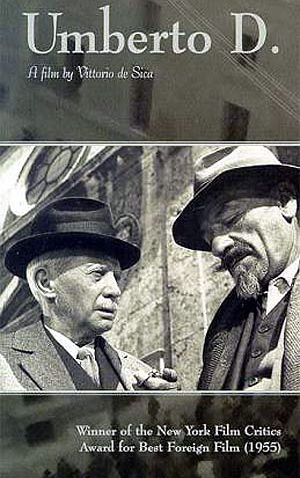
UMBERTO D
Italy, 1951, 88 minutes, Black and white.
Carlo Battisti, Maria Pia Casilio, Lina Gennari.
Directed by Vittorio de Sica.
Umberto D is a fine example of Italian neo-realistic cinema. Vittorio de Sica had already made the famous examples of this genre - Shoeshine (1946); Bicycle Thieves (1947); Miracle in Milan (1951). This study of ageing and loneliness he dedicated to his father. The film was a commercial failure, although critically praised. The main role was played by a University professor from Florence, Carlo Battisti. His performance is most moving, and along with it some of de Sica's superb 'natural' touches go to make this film memorable. Its quality can be compared with the other neo-realist films by de Sica.
Vittorio de Sica is both director and actor. After a period out of favour with the critics, he regained it with an Oscar for The Garden of the Finzi-Contini? (1971).
1. What did Umberto represent - as an individual and as a member of society?
2. What qualities of personality and character did he have, and how were they presented and communicated?
3. How did the dedication, introductory note and opening sequences of the demonstration create an atmosphere for the film? How evident was it that the film was critical of Italian society of its day and urging practical reform?
4. Why was Umberto D lonely? Was age the reason for this, his retirement, lack of friends?
5. How did the dispersed pensioners become victims? Was Umberto D a victim? If so, of what?
6. How preoccupying was his need for money - trying to sell his watch and books? How desperate was he and how humiliating was this for him?
7. How important was Flick for Umberto D in the film?
8. How important was Maria for Umberto?
9. The landlady - what did she represent, her friends, behaviour, singing, lack of feeling in life? Did she have any reason to be harsh?
10. The hospital sequence - was it funny, touching?
11. Why was the sequence of Maria at home so effective?
12. How did Flick keep Umberto alive and lead him to hope?
13. What insights into human nature, loneliness, ageing, love, society, arrogance, humility, hope, did the film offer?
14. What qualities make this a critics' master-piece?
15. De Sica's attention to 'detail in techniques and theme, e.g. begging and Flick holding the hat, Umberto's meeting people as at the demonstration, in hospital, the friend at the bus-stop, the Commandant; the landlady hiring the room, re-doing the house? The hospital: health, rest, food, the sisters (Rosary), seeing Flick? the realism of the morning sequence with Maria? Recovering Flick at the pound? The hole in the wall as a culmination of anguish about money, illness, cold, inability to sleep, threats of eviction? Umberto in the park? His trying to give Flick away? The possibility of suicide: the pavement, the train?